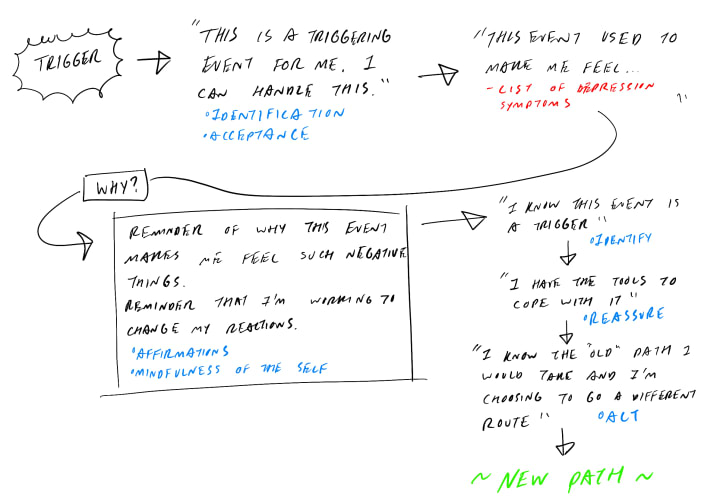Beating Depression's Beaten Path
Mapping out a happier way to live life

Human beings are creatures of habit. We have a subconscious bias toward doing everyday things in certain ways that feel comfortable to us. I put my left sock on before the right one, but I always put my right shoe on before the left. I brush my teeth in a certain pattern; I shave my face from left to right. Whatever the task is, I definitely don’t remember choosing the particular way in which I complete it. As a child I learned the basics but as I grew older I simply found a way of doing them that just felt comfortable to me. If not by the lack of discomfort, but by the reinforcement achieved by repetition. Either way, our brains employ a flavor of the ‘path of least resistance’ strategy with these simple tasks; that being said, would it not make sense that our brains also employ this strategy with other functions buried even deeper in our subconscious?
In my experience, the symptoms of my depression would follow a path developed by my subconscious proceeding a triggering event. This path looked something like this:

In red are the symptoms of depression that I most commonly felt during this path. The path would usually end with me spending the rest of the day locked in my room, overwhelmed by the intense feelings of despair and hopelessness. On occasion, it would lead to self-harm.
It’s important to note that the triggering event would create the feeling of frustration, but then my mind would create a narrative around that emotion. The narrative would then bleed into the next emotion, and I would once again create a narrative around that. I was experiencing difficult emotions, and my brain was creating a dialogue that made those emotions make sense in the context of what was going on around me. This was very dangerous because the emotions were very negative ones, and as someone unexperienced with the coping methods learned through therapy and counseling, my narratives were always going to be self-deprecating.
This was the path my brain travelled when experiencing a triggering event. It was familiar to me, and it did not take any energy to fall into it each time I became frustrated. It was, for that reason, comfortable. Just like putting on my socks and shoes, just like brushing my teeth, this was the way I’d always done it. I did not choose to create this path; it was a path created by the flow of traumatic emotions and events through my subconscious during the developmental stages of my life. It became my depression’s beaten path and a reliable way for those emotions to take over my life.
Through time and conscious effort I was able to break from this path and create a new one; that is the beauty of our minds. At any stage in life we are able to reroute the path of thoughts and emotions to work in our favor, so long as we employ the drive and consistency to do so. The solution will be different for everyone, but here I’m going to do my best to explain how I was able to overcome this beaten path.
My counselor and I spent a lot of time identifying the paths for each of my major triggers. Some began with frustration, others with sadness. Some paths were complicated and others were more direct. Regardless of the path, each one followed the emotion-narrative template described earlier. Once the details of each were identified we revisited the source of the triggers; something we had done during my first few months in therapy. This step was very important in the identification process because it allowed me to make the connection between my experiences and my emotions. Without that it would have been easy for me to detach myself from the healing process, which likely wouldn’t have allowed me to make the persistent pathways my brain follows now during those same situations.
Once we’d identified everything, and I felt confident in my knowledge of my own emotions and reactions, I needed to create the alternative paths. This was the tricky part, because creating these new pathways for my brain to follow was not a tangible thing. My counselor suggested I start by asking myself how I’d like to react to my triggers. We talked a lot about what a “healthy” reaction to those triggering events would be, in my eyes, and then we could begin breaking those down in the same way we did my current reactions.
Again, these new paths are going to be different for everyone. What’s important to remember is that identifying the need for new paths to handle triggering events is the first step in breaking away from the old ones. That being said, my game plan and the path I follow now, looks like this:

For me, the first step is identification and acceptance. I tell myself that I know this event is hard for me, but I can handle it. Then, I find it necessary to remember how these events used to make me feel. This step isn’t for everyone, but it helps me keep a balanced perspective on the difficult emotions. I’ll continue to ask myself why the event makes me feel those negative emotions, and I’ll remind myself that I’ve worked through the issues before and I’m still working to change my reactions to be as healthy as I can be. This is typically where I’d lean on my affirmations and really take mental notes about how I’m feeling in that exact moment. From there I can begin to react in the way I’d planned to react when talking with my counselor. Once again I’ll identify the trigger, I’ll remind myself that I have the tools and skills to cope with it, and then I consciously choose to think along the lines of the new path that I created.
Yes, this is a lot of work and it is exhausting, especially if the events that trigger you happen often. Many times, when I first started to use this healing method, I had to stop whatever I was doing and run myself through the steps in the above illustration. Sometimes I was at work and with a customer and I couldn’t completely stop what I was doing. At those times I would focus on my breathing and whatever I was helping the customer with. It was a practice in mindfulness that kept my brain from falling into those negative thoughts at that moment. Then, at the next opportunity, I would take a seat somewhere and run through the steps. It helped to keep a copy of the outline on my phone, or even just a few notes of the affirmations I felt were the most helpful.
The exhaustion I felt the first few times doing these were absolutely affecting my energy throughout the day, but over time it became easier and easier until I hardly had to think about my new coping skills at all. Through that hard work came results that I hadn’t thought were possible even a few months prior.
There was no one-size-fits-all for every situation. My philosophy with this was to keep as many “tools” on me at all times so that I would never feel unprepared when those destructive feelings arose within me. Usually that was a physical copy of my affirmations or notes on my phone from my last couple therapy sessions. It was also helpful for me to keep a physical copy on instructions for mindful breathing in the moment. They were all tools that I felt helped me the most, and they were ones that I was comfortable using at any time and in any place.
At this stage of my healing process I was constantly reminding myself that my tools existed to help me build that new path for my mind to follow when I was presented with difficult emotions. There were days where I really didn’t think I could keep doing it. There were days I wanted to give up, when life got crazy and it felt as though I’d never have the time to put in the work to heal myself in this way. I failed often, but I failed quickly and I did my best to take each failure as a learning opportunity. I was honest with myself and my counselor about my failures, and those were the lessons that were the hardest to swallow but they were also the ones that stuck with me the longest.
About the Creator
Mac
Welcome to my page, enjoy.
Fun fact: most of the photos on my stories are original photos by me. Comment if you like them; or if you want to know the story behind them!







Comments
There are no comments for this story
Be the first to respond and start the conversation.